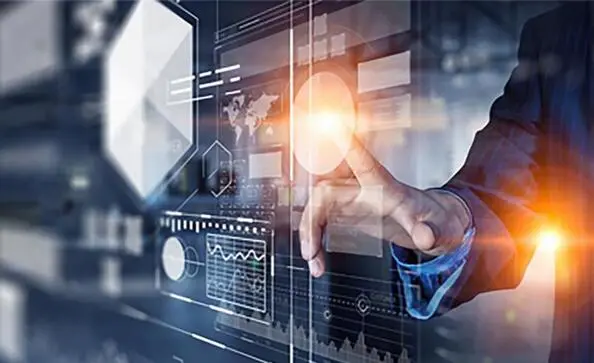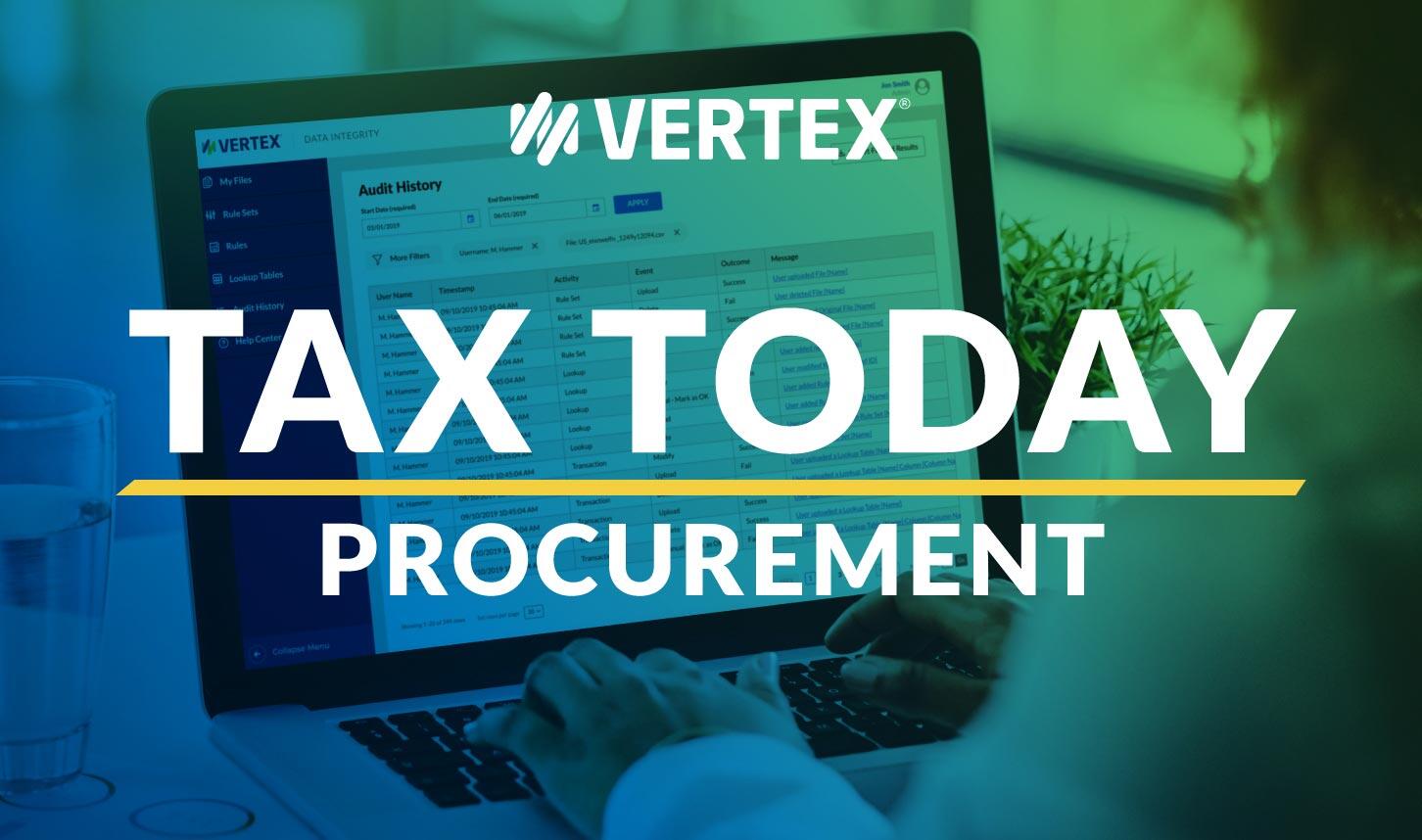MS. SCHWABENBAUER: Hi, I’m Kristin Schwabenbauer. Welcome to Tax Today, a Vertex podcast series. On today’s episode, we’ll be exploring indirect tax and procurement landscape opportunities and challenges in the US with Tiffany O’Neil. Tiffany is a practice leader with Vertex Consulting who specializes in both VAT and procurement implementations. She brings more than eighteen years of experience in tax and tax automation. She has participated in over 50 engagements integrating tax applications with ERPs and various billing and procurement applications. She has a deep understanding of business applications and how to incorporate accurate tax decisions into business processes.
Prior to joining Vertex, Tiffany was a director at a global tax services firm specializing in implementing third-party tax software packages. Tiffany, welcome. Thanks so much for taking the time.
MS. O’NEIL: Thanks, Kristin. I’m happy to be here.
MS. SCHWABENBAUER: Fantastic. So I wanted to start off by asking you a question, and it’s a big one, so let’s just dive right into it, shall we? Why is automating tax decisions on procurement transactions so difficult in the US? Can you talk about that?
MS. O’NEIL: Yeah. It’s difficult because of the availability of data. And it’s useful to think of the differences between the sales and purchase processes. During the sales process, companies know everything about the goods and services they’re selling. They know exactly what they’re selling, they know who they’re selling it to, and their business systems have SKUs, product groups, and all the customer data they need to make accurate tax decisions.
During the purchasing process, companies know what they’re buying, but not necessarily with the same level of granularity. Software is a great example. To accurately tax software in the US, you may need to know if it’s custom or canned, if it’s installed from a disk, electronically delivered, hosted, or even Software as a Service. And the purchasing system will likely have some useful data, but you have to think about the purpose of the system. Purchasing systems are intended to make it easy for buyers to request items. And they want to make sure buyers are requesting items for vendors. They want to get approval routed so they get the appropriate approval workflow. And there is some categorization for spend analytics, and there’s the assignment of correct accounting detail.
So for the example of the software, the system will indicate that it’s software and what ledger account to charge it to, but the systems aren’t designed to provide the same details required for taxability determination. And software is an extreme example; I use it all the time. Many items are easy to set up accurate tax decisions, but there are cases that are more difficult. And then additionally there are usage-based exemptions in the US. And that’s commonly known as something where taxability is not based off what you’re buying, but how you’re going to use it.
And manufacturing is a common example. Machinery and equipment directly involved in the manufacturing process can be exempt. This requires additional data points beyond identifying what is being purchased. There is often useful data that provides insight into the part of the organization making the purchase, such as departments or cost centers. But these data points don’t always line up with the tax rules. In many cases, a solution to data gaps needs to be designed.
MS. SCHWABENBAUER: Thanks, Tiffany. You brought up so many really good points. And I think that’s really a lot of what I’m seeing and have been seeing over the past couple years, whether we’re working with ERPs or we’re working with best of the best of breed procurement providers out there. They’re meant to be big procurement ERPs, if you will.
But do they take everything into account for what you need to determine tax? And how do you gain efficiencies, and tax touches everything, so you have to take those things into consideration. So those are all some really good points.
I see this area as a big spot where it’s going to evolve. The functionality is going to have to evolve, these procurement best of breeds are going to have to evolve what kind of functionality they give us so that we can calculate tax more accurately.
So along those lines, what do you need to be, or what would you suggest that folks need to be successful around the procurement process early on? So if people are engaging as we recommend as a best practice, saying, hey, tax people, work with your procurement people. Procurement people, work with your tax people; work as a team. What do you suggest folks need to be successful?
MS. O’NEIL: It really is that they get together early on. If the data from the purchasing process is intended to be used for tax decisions, the purchasing team needs to understand what data the tax team needs. And the tax team needs to understand exactly how the organization plans to use the purchasing application. And if they can come together and they can both see each others’ side of the equation, you can design the solution, you can collaborate the correct system data, and you can create the correct business processes to successfully automate tax.
MS. SCHWABENBAUER: Yeah, I think that’s key. If you can team up early, do it; early and often. You’re part of the same team; you’re going to have to pay invoices and get your efficiencies out there. Tax is a part of that. If tax isn’t right on those invoices, it’s going to slow down your procurement process and slow down paying your invoices, and that’s a major issue. So I know when we talk to clients, a lot of times what happens is we say, oh, even during the implementation, you want tax part of the blueprinting stage, and you want them part of the testing stage.
It all really falls in line for every part of an implementation, if you will, whether it be ERP or a best of breed procurement vendor. So we talked a little bit about some of the negatives with procurement platforms. What are some of the benefits of these procurements platforms that our clients are experiencing?
MS. O’NEIL: We really can get a lot more tax relevant data about purchases if a purchase system is implemented, and especially if tax is considered from the beginning. Even the consistent use of requisitions and purchase orders in a system helps companies. Without a purchase order, AP invoices have minimal data. The clerks are basically entering a vendor, an amount, the accounting details, and where the check needs to go. Purchase orders alone add so much more detail. There’s always some sort of categorization of the purchase.
And then there’s always a ship to address. When people are ordering something to be delivered, they want to receive it, so you do have information about where goods are going to be sent, or what location a service should be provided at, and all the data is there. So there’s always an opportunity to ensure there’s correct data for taxation if you have those data points there from the beginning.
MS. SCHWABENBAUER: Yeah, that’s a really good point. I’ve heard from a lot of clients, that they say, well, this best of breed doesn’t have tax on PO or it doesn’t enable that the functionality isn’t there. And I always thought if it was just for budgeting reasons, but I didn’t realize there’s just so much more than just that. It’s not just running reports and saying, hey, here’s our total estimated spend including tax, which could be hundreds of thousands of dollars; it’s more than that.
And I think that’s really important. And part of this podcast series, what we really want to do is make sure tax folks are aware, but also procurement professionals are aware of all those different tax touch points in the process that can really help the process along and are critical helping to, again, team up with tax and make sure you’re protecting your company and paying your invoices efficiently and timely and accurately and all that. So, let me ask you this. Can you speak to the evolution of procurement in the newness in the ERPs? How do we set expectations with folks; how do we do that?
MS. O’NEIL: We have been automating tax and procurement in ERPs for years, and there’s always been data limitations. But the integrations have evolved to really provide maximum data, and we’ve developed a lot of standard best practice approaches for the data gaps. And so we do have a lot of suggestions with the major ERPs. Now that we’re seeing a lot of new procurement applications, we’re also seeing a lot of new integrations. And new integrations often have some limitations. And we’re constantly working with our customers and partners to improve them. But it is a very exciting time in this space because we are seeing a lot more companies take advantage of automation and really improving their end to end business processes through these integrations.
MS. SCHWABENBAUER: No, that’s fabulous. That makes so much sense. And some of the points that you said that really resonate with me is that this is new; a lot of this is new. It’s been in ERPs for years, back in the day when you could fudge some things or everything wasn’t in the cloud so you could mess around with things and do workarounds. You might not have that so much with the cloud based best of breeds. And this is evolving. And so I think going into this with the right expectations from both procurement and tax and IT, you’re going to have to be flexible, you’re going to have to work with both the tax vendor, Vertex, as well as your procurement vendor, and it’s a growth opportunity. We need your feedback to make sure that we understand why you need what functionality you need and why it might not be in there at this point, and how do we get there. So I think those are all really good things. They’re challenging.
I’ve seen it where folks are really, I think you’ve got like Amazon Prime or the iPod. You’ve got everything right at your fingertips. So now everyone thinks okay, well now everything is in the cloud, so now just poof and it’s going to be there; it should all be there. Or what should be in the ERP and has been for years is automatically going to be in these best of breed procurement providers, especially regarding tax, and it’s not.
If you look at the evolution of these partnerships in these relationships, Arriba, for instance, didn’t partner. They had no partner; it was just ecosystem. The tax API was one of the newest APIs and they just did that a couple years ago. And same thing with Kupa. Kupa’s partner program is still evolving.
So we’re all working together to try to move this forward, but working hand in hand with clients and making sure that they understand that this is an area for growth. And really the vision of this -- I’m so excited -- is to work with folks like you that are really technical and have so much experience, and we can team up with the partners and the clients to see where we can take this in the future. We’re automating things now, but what’s it going to look like in the future when we really all team up together and work together to figure this out, so that’s really exciting.
Well, Tiffany, I can’t thank you enough for taking the time and speaking with us. We appreciate it. That’ll do it for today’s show. I’d like to thank my guest, Tiffany O’Neil for joining me, and thanks to our listeners. Make sure you tune in for our next episode when we will discuss indirect tax and procurement landscape, opportunities and challenges in the US with global VAT with our friend, Donal Colbert.
Indirect Tax in Procurement – Landscape, Opportunities, and Challenges
Episode 3 of Tax Today: Procurement

Episode 3 Summary
Why is automating tax decisions on procurement transactions so difficult in the U.S.? Vertex Consulting practice leader, Tiffany O’Neill provides some insights. In this episode, we explore the indirect tax and procurement landscape, opportunities, and challenges in the U.S, and what tax automation is going to look like in the future.
In under 15 minutes, hear Tiffany explain how purchasing systems lack certain transaction data because they aren’t designed to provide the same detail for tax determination. Taxes aren’t only based on what you’re buying but how you’re going to use it. Hear Tiffany and Kristin’s thoughts on how these processes are going to need to evolve to calculate tax accurately, how different teams can come together early to design a solution, and how you can overcome data limitations.
Episode 1: Why is Indirect Tax in Procure-to-Pay So Critical?
Episode 2: The Differences in Tax in the Procure to Pay Process: U.S. vs. Global
Episode 4: Indirect Tax in the Procurement Landscape: Opportunities and Challenges with Global VAT
Episode 5: Industry Perspective: Integrating a Tax Engine for a Global Motor Manufacturer
Episode 6: Aligning Tax and Procurement to Streamline Business Processes
Episode 7: Key Considerations When Deploying a Tax Solution for Procurement
Episode 8: Invoicing Explained: Understanding Indirect Tax During the Procurement Process
Episode 9: Keys to a Successful Procurement Platform Implementation
Episode 10: Tax Reporting: Why Internal Audit and The Sarbanes-Oxley Act (SOX) are Essential
Episode 11: Technology Trends in P2P and Tax Automation
Episode 12: Understanding International Accounting: Global Indirect Tax and Procurement
Episode 13: Integrating Vertex with SAP Ariba: An Overview
Episode 14: Consumer Use Tax Audits: Pain Points and Solutions
About the Series
Still haven’t cracked the code on indirect tax and procurement? Let us help. On Tax Today, a Vertex podcast series, host Kristin Schwabenbauer holds enlightening discussions with tax, IT, and procurement specialists focused on shaping tax in the procure-to-pay process. Tune in every week for words of wisdom to help you transform tax.
Why add a tax engine for procurement?
Integrate a tax engine to improve tax accuracy and streamline procurement processes. Learn how in this video.
WATCH VIDEO
